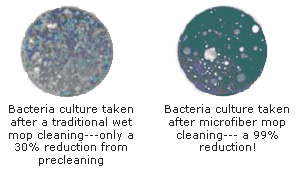American Medical Association Considers
Banning Doctors’ White Coats
by www.SixWise.com
At the American Medical Association’s annual conference, an unusual policy question was placed on the table: Should doctors abandon their white coats?
The concern comes from studies showing the potential for the long-sleeved garments to harbor dangerous bacteria like MRSA and C. difficile, and transfer it from one patient to the next.
|

The majority of medical personnel at some hospitals say they change their lab coats less than once a week, even if they know it’s contaminated!
|
The AMA was considering adopting a “bare below the elbows” dress code to help protect patients from unnecessary infections.
In the end, the AMA decided the matter deserves more study before a ruling can be made, but this is not the case in some other countries. Britain has banned not only long-sleeved white coats but also ties, jewelry and other items from physicians’ wardrobes for two years now. Scotland also banned the white coats and ties and instead created a national uniform of color-coded scrubs for all health care workers.
Even within the United States, some hospitals have taken matters into their own hands. At The Mayo Clinic, for instance, white coats are not allowed and doctors instead wear business attire.
How Clean is Your Doctor’s Coat, Really?
In the United States, there are more than 2 million hospital-acquired infections every year, according to the National Nosocomial Infections Surveillance (NNIS) System of the Centers for Disease Control and Prevention (CDC). This results in an additional 17,500 to 70,000 deaths and an added expenditure of over $4.5 billion.
Although there is no conclusive evidence showing what percentage of these infections were caused by contaminated clothing, research has shown that dangerous and antibiotic-resistant bacteria does, in fact, exist on health care workers’ sleeves and can thrive there for up to 56 days.
And, (cover your eyes here if you don’t want to read something disturbing!) the Wall Street Journal reported that 65 percent of the medical personnel at the University of Maryland said they change their lab coat less than once a week, even though they know it’s contaminated!
Further, 15 percent said they change it less than once a month!
There is also some telling evidence of what’s happened once dirty clothing was nixed from the hospital setting:
-
At Monroe Hospital in Bloomington, Ind., where hospital-acquired infections are nearly non-existent, laundered scrubs are provided to all staff and scrubs may not be worn outside the building (health care workers can also carry dangerous germs out into the public by wearing their scrubs or white coats to restaurants, on public transportation, etc.).
It’s not only white coats and long-sleeved scrubs that are the problem. Neckties have also been found to harbor germs.
In one study, researchers analyzed the neckties of 42 doctors, physician's assistants and medical students at a hospital. The ties of 10 hospital security guards were also included in the analysis.
|
PerfectClean Cloths:
Don't Leave Home Without Them

PerfectClean hand wipes are an essential tool for keeping germs at bay. The cloths are made with a revolutionary ultramicrofiber construction that enables them to reach deep into microscopic crevices (NO other cleaning tool available even comes close!) to actually remove dirt and bacteria, not just push it around like ordinary cleaning rags.
Plus, these cloths are small enough to slip into your pocket, purse, or desk drawer, and you can use them without any cleaning products or water. Simply pull out the cloth, wipe off your hands, and enjoy the peace of mind in knowing you’re taking an incredibly effective step to keeping germs away.
|
It was discovered that nearly half -- 47.6 percent -- of the neckties that belong to the doctors contained germs that can cause illnesses such as pneumonia and urinary tract infections. Further, the odds of a doctor wearing a necktie harboring pathogens were eight times greater than that of security personnel.
What’s the Case for Keeping the White Coat?
It may seem a simple decision to ban white coats, long-sleeved scrubs and neckties, and simply offer all staff hospital-laundered scrubs (a practice that existed at most hospitals in the United States up until about two decades ago).
But it’s not so simple. Some people, doctors and patients alike, believe the white coat is necessary to make a doctor stand out from the crowd and bolster their authority. Many medical schools across the United States even host “white coat ceremonies” during which first-year med students are given their first garment.
On the other hand, others believe the doctors’ coats should be banned if there’s even a hint that they could be making people sick (and still others who feel the coats are alienating or anxiety-causing would also love to see them go).
For now, however, it’s likely you’ll continue to see white coats and long-sleeved scrubs at a hospital near you … so what can you do to stay safe?
First and foremost, wash your hands often, especially before eating and after going to a doctor’s office, hospital or really any public place. For times when soap and water is not available, we highly recommend keeping a PerfectClean Hand Wipe in your pocket, and using it frequently to wipe off your hands throughout the day (especially after shaking hands, touching doorknobs or other public areas and before eating).
These commercial-grade cloths have patented built-in antimicrobial protection, and are made of 100% safe ultramicrofibers that are only 3 microns in size, which is even smaller than many bacteria. A quick wipe of your hand will clean it down to a microscopic level!
You can also minimize your risk of hospital-acquired infections by keeping your health in check with a healthy lifestyle, and therefore avoiding the need to see a doctor or go to a hospital as much as possible.
Recommended Reading
Is Your Doctor Skimping on Giving You the Best Advice?
10 Things You Need to Remind Your Doctor to Do on Your Next Clinical Visit
Sources
MedCityNews.com July 13, 2009
The Wall Street Journal June 16, 2009
The Wall Street Journal June 12, 2009
eMedicine January 14, 2009
The Wall Street Journal January 8, 2009
BBC News December 16, 2008